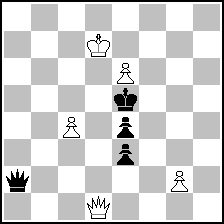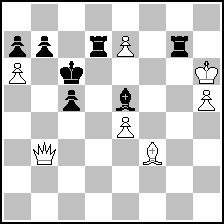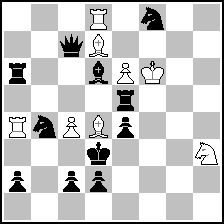
Website founded by
Milan Velimirović
in 2006
19:48 UTC


| |
MatPlus.Net  Forum Forum  General General  "Parity" Helpmate "Parity" Helpmate |
| |
|
|
|
|
You can only view this page!
| | | (1) Posted by Hauke Reddmann [Tuesday, Jun 19, 2007 17:40] | "Parity" Helpmate
Today I hacked together a (rather gruesome) helpmate,
White begins, four solutions, connected like
I 1.A1 B1 2.C1
II 1.A1 B2 2.C2
III 1.A2 B1 2.C2
IV 1.A2 B2 2.C1
If A1 would be the set/try of a twomover and A2 the solution,
it would be a reciprocal mate transfer. Ever seen this in a
helpmate? Then shoot! (I also shot, myself in the own foot,
by insisting A1 and A2 are promotions to Q and S. Made the
construction fiendishly difficult, and of course I get an
underpromotion dual for free...)
Hauke
| | | (2) Posted by Harry Fougiaxis [Tuesday, Jun 19, 2007 20:41] |
A piece-of-cake query for WinChloe! I found 16 such h#2 in the database, the idea was apparently popular mainly among Italian and Israeli composers. The first example seems to be 40 years old. Yet, nothing came out with promotions, so your effort might be original :)
Of course, most of them suffer from bad economy although this is quite normal (and I would say, acceptable) in this type of helpmates, since they are, in fact, "pushed" direct twomovers...
Check the pdf @ http://users.forthnet.gr/ath/harryfou/reciprocal_changes_in_hm2.pdf
There are also another 20 examples or so with cyclic changes (WinChloe uses the term "Lacny split over three phases"), with most of them based on cyclic self-blocks or guards of bK flights.
I quote here a simple but very elegant problem by Boyer, and one by myself in which I tried to embed an anti-battery in the mechanism. | Jean-Pierre Boyer
2 Pr 3 TT Sinfonie Scacchistiche 1967-68
 (= 5+4 ) (= 5+4 )
h#2
1.3.2.1
1.Qf2 Ke7 2.Qf4 a Qd5# A
1.Qf2 Ke7 2.Qf5 b Qd6# C
1.Qf2 g3 2.Qf5 b Qa1# B
1.Qf2 g3 2.Qf6 c Qd5# A
1.Qf2 g4 2.Qf4 a Qa1# B
1.Qf2 g4 2.Qf6 c Qd6# C | Harry Fougiaxis
Pr Mat 1984
 (= 8+14 ) (= 8+14 )
h#2
1.3.2.1
1.Gc5 Sxe6 2.Nd3 a Gcf5# A
1.Gc5 Sxe6 2.Gd5 b f5# C
1.Gc5 fxg5 2.Gd5 b Sf5# B
1.Gc5 fxg5 2.Gd4 c Gcf5# A
1.Gc5 Gg8 2.Nd3 a Sf5# B
1.Gc5 Gg8 2.Gd4 c f5# C |
| | (3) Posted by Hauke Reddmann [Wednesday, Jun 20, 2007 11:05] |
Interesting but not *quite* what I had in mind.
Ah well, since there is no chance that I can publish the
thing due to the in-built promotion dual I might as well
post it here as Forum Original:
 (= 7+7 ) (= 7+7 )
h#1.5 (2.2.1 or how do you describe that?)
There are four interleaved solutions:
1...e7-e8=S 2.Be5-c7 Qb3*b7 #
1...e7-e8=S 2.Be5-d6 e4-e5 #
1...e7-e8=Q/B 2.Be5-c7 e4-e5 #
1...e7-e8=Q/B 2.Be5-d6 Qb3*b7 #
Hauke
P.S. Maybe one can make a 2# out of this matrix after all,
but I doubt it...
| | | (4) Posted by Harry Fougiaxis [Wednesday, Jun 20, 2007 11:21] |
QUOTE
Interesting but not *quite* what I had in mind.
In terms of "algebra", the examples fit the pattern play, don't they?!
Nevertheless, your mechanism is indeed novel, although I can't see how one could get rid of the dual.
QUOTE
h#1.5 (2.2.1 or how do you describe that?)
Yes, "2.2.1" is correct.
| | | (5) Posted by Sarah Hornecker [Wednesday, Jun 20, 2007 11:31] |
On the other thread we already agreed this is not a real dual so it shouldn't decrease the worth of the helpmate.
| | | (6) Posted by Harry Fougiaxis [Wednesday, Jun 20, 2007 12:10] |
This is irrelevant to what is discussed in the codex thread. Here we have a dual in the W1 move, there we are dealing with promotion mates. Article 13 specifies that promotions into different pieces having partially the same power may be tolerated only if they occur in the final move.
| | | (7) Posted by Hauke Reddmann [Wednesday, Jun 20, 2007 12:24] |
@Harry: Yup, the pattern is the same - as soon as you chop off
the first move of Black which always repeats. (Why I left it
out anyway.) I wondered if *specifically* h#1.5 with this
pattern existed too.
Hauke
| | | (8) Posted by Frank Richter [Wednesday, Jun 20, 2007 13:52] |
I'd prefer "0.2.1.1" for describing a helpmate.
Very nice scheme - this should be done without the ugly promotion. But how?
| | | (9) Posted by Harry Fougiaxis [Wednesday, Jun 20, 2007 15:40] |
QUOTE
I'd prefer "0.2.1.1" for describing a helpmate.
It is interesting that Milan and myself have been discussing about the very same point recently. That thread is in the Editorial group, where access is obviously restricted, so let me quote our conversation:
QUOTE
Harry: The twin should read 21111 (if you write h#2.5 it is 21111, if you write h#3 it is 0211..., I prefer the former)
QUOTE
Milan: I added the zero for "white begins" helpmates (as I did in Spring issue). For me it was more logical, and also a kind of double-check that readers would understand the stipulation, but I admit that it looks like pleonasm. However, it is not a matter of logic (which might vary from person to person) but a convention - is there any convention?
I prefer the full number of moves and leading zero (as is the practice in Die Schwalbe, for instance), but I think that we can agree with Harry: if white begins then we'll omit the leading zero - pity it was not done this way the first issue, I am the one to be blamed for!
QUOTE
Harry: My opinion/vote: indicate the half moves and do not use the leading zero (i.e., as in WinChloe). The classic term used by the Germans is, of course, equally OK, but I think that in help-play problems where White plays first it is more user-friendly to indicate the half-moves. In any case, h#2.5 0211.. is not accurate, and I don't like it. The void black move is already mentioned in the stipulated number of moves, and it is not necessary to repeat this on the note how the solutions run.
Another test before you decide: how should we designate a h#3 W-> which has also set play? I think that h#2.5* is easier for the average reader to understand than h#3* 0111...
Well, what do you think?
| | | (10) Posted by Frank Richter [Wednesday, Jun 20, 2007 16:12] |
Interesting. Well, I'm a classic German, so I'd prefer in classical helpmates "h#n 0.2;2.1" etc.
But if there is set play too, I think "h#n,5*" is more understandable.
Both versions are possible.
By the way - the italic font in quoted texts is very bad to read.
| | | (11) Posted by Harry Fougiaxis [Wednesday, Jun 20, 2007 18:46] |
QUOTE
I wondered if *specifically* h#1.5 with this pattern existed too.
I found in WinChloe just a single example of reciprocal changes and another one with cyclic, here you are: | Václav Kotěšovec
5 Comm e.a. The Problemist 1988
 (= 9+9 ) (= 9+9 )
h#1.5
2.2.1
Madrasi
1...Gh5 2.f6 a c4# A
1...Gh5 2.f5 b c3# B
1...Gh8 2.f6 a c3# B
1...Gh8 2.f5 b c4# A | Michel Caillaud & Peter Gvozdják
7 HM V. Kotěšovec-40 1996
 (= 4+10 ) (= 4+10 )
h#1.5
3.2.1
1...E4c6 2.0-0 a Re7# A
1...E4c6 2.0-0-0 b Eac4# B
1...Ee6 2.0-0 a Eac4# B
1...Ee6 2.0-0-0 b Eg4# C
1...E4g6 2.0-0 a Eag4# C
1...E4g6 2.0-0-0 b Re7# A |
| | (12) Posted by Joost de Heer [Monday, Jun 1, 2009 17:08]; edited by Joost de Heer [09-06-01] |
From Cyclone:
Gideon Husserl
Special prize, Sinfonie Scacchistiche 10.-12.1977
 (= 4+7 ) (= 4+7 )
h#1.5 1.3.1 (b) Qf6->e8 (White king in check)
a) 1... Qf6 2. Re7(a)/Rc7(b)/g5(c) 2. Qc6(A)/Rd8(B)/Qe6(C)#
b) 1... Re8 2. Re7(a)/Rc7(b)/g5(c) 2. Rd8(B)/Qe6(C)/Qc6(A)#
Lacny
Michel Caillaud
Special HM, 1st TT Pat a mat, C 16.11.1992
 (= 8+11 ) (= 8+11 )
h#1.5 2.2.1
1... Bb5(A) 2. Sc6(a)/Bc5(b) c5(B)/Sf4(C)#
1... c5(B) 2. Sc6(a)/Bc5(b) Sf4(C)/Bb5(A)#
Kiss
| |
No more posts |
MatPlus.Net  Forum Forum  General General  "Parity" Helpmate "Parity" Helpmate |
|
|
|
| |
| |
 ISC 2024
ISC 2024 Forum
Forum  General
General  "Parity" Helpmate
"Parity" Helpmate 


